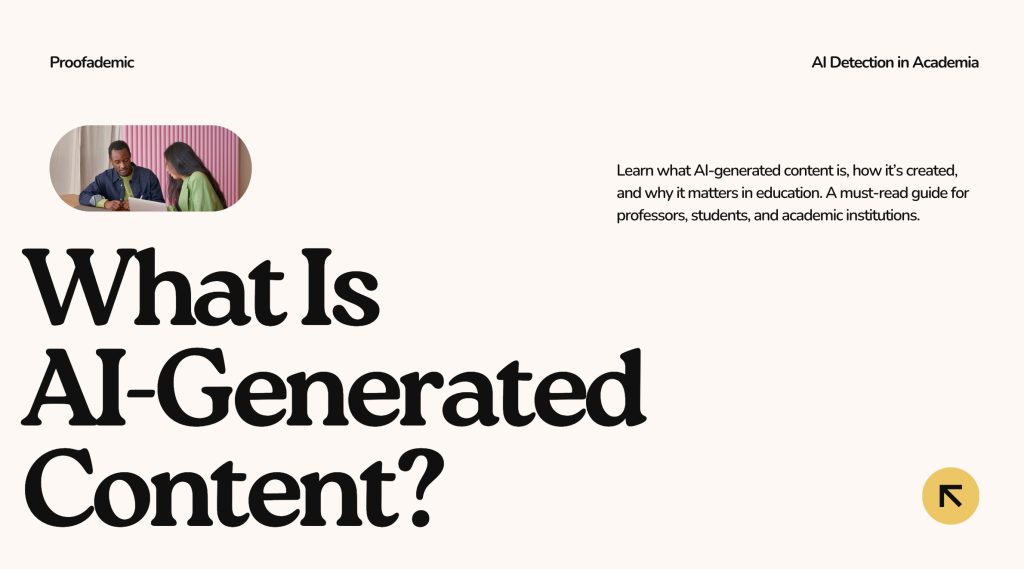AI writing tools are transforming the way students and educators approach academic content. From full-length essays to research summaries, generative AI has made it faster than ever to produce polished, human-like writing. But with that rise comes a crucial question in education: what is AI-generated content—and why does it matter?
Whether you’re a student trying to stay compliant with academic policies or an educator navigating the new digital landscape, this guide breaks it all down.
What Is AI-Generated Content?
AI-generated content refers to any text, assignment, or written material created by artificial intelligence tools. These tools—like ChatGPT, Claude, or Gemini—use natural language processing (NLP) and deep learning models to generate language that mimics human writing.
Unlike traditional plagiarism, which involves copying existing work, AI-written content is typically original in structure and wording—making it much harder to detect with conventional plagiarism checkers.
How Is It Created?
AI tools use large language models (LLMs) trained on billions of data points—including books, websites, and scholarly articles. Based on a user prompt, they predict and generate coherent paragraphs of text.
For a deeper understanding of how these systems work, check out this explanation from Stanford University’s CS Department.
Common Use Cases in Academia
In academic settings, AI-generated content is often used to:
- Write essays or discussion posts
- Summarize lengthy research papers
- Generate citations or abstracts
- Brainstorm project ideas
While these uses can seem helpful, they may conflict with academic integrity policies.
Why It Matters in Education
The use of AI in classrooms has sparked widespread debate—and growing concern—among educators. In a survey by Inside Higher Ed, 85% of instructors reported uncertainty about how to address student use of generative AI.
Challenges for Educators
- Traditional plagiarism tools can’t catch AI-written text
- Students may not fully understand when AI use becomes misconduct
- It’s difficult to verify authorship without a detection system
Academic Integrity Concerns
Many universities and colleges have policies that now include guidelines for AI use. Submitting AI-generated work without disclosure can violate academic honor codes—leading to penalties ranging from assignment failure to expulsion.
The International Center for Academic Integrity emphasizes that unauthorized use of AI tools may constitute a form of academic dishonesty, even if the work is technically “original.”
How to Spot AI-Generated Text
AI-generated writing tends to follow a certain pattern. While it’s often fluent and error-free, it lacks the nuanced human touch.
Here are some signs to look for:
- Repetitive sentence structures or phrases
- Lack of detailed personal reflection or experience
- Overly formal or robotic tone
- Generic introductions and conclusions
- Minimal use of citations or references
For best practices on detecting and responding to AI use in education, UNESCO offers a global framework.
What Students Should Know
If you’re a student, it’s crucial to understand your institution’s policy on AI usage. While tools like ChatGPT can be helpful for brainstorming or outlining, submitting full AI-generated essays without acknowledgment may violate school rules—even if you think of it as “just getting help.”
If in doubt, always ask your instructor or refer to your university’s academic integrity policy.
Conclusion
AI-generated content is reshaping education—and fast. For students, it offers efficiency and speed. For educators, it raises critical questions about authorship, integrity, and learning outcomes.
As AI continues to evolve, staying informed is key. Understanding what AI-generated content is—and how to manage it ethically—helps ensure we maintain academic honesty in a tech-driven world.
For ongoing insights, best practices, and detection tools tailored to academia, be sure to subscribe to our newsletter.

